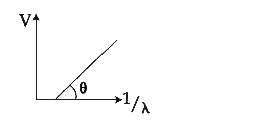In a photoelectric experiment, it was found that the stopping potential decreases from 1.85 V to 0.82 V as the wavelength of the incident light is varied from 300nm to 400nm. Calculate the value of the Planck constant from these data.
The maximum kinetic energy of a photoelectron is
(Kmax=hcλ−φ)
and the stopping potential is
V=(Kmaxe)=(hcλe)−(φe).
IfV1,V2,arethes⊤πngpotentialsatwave≤n>hs<br>λ1andλ2respectively,<br> V_1 = (hc/lambda_1 e)- (varphi/e)<br> and V_2= (hc/ (lambda_2 e)-(varphi/ e)).<br> This gives, V_1- V_2 = (hc/e) ( 1/lambda_1) - (1 / lambda_2)
or,h=(e(V1)−(V2)c(1λ1)−(1λ2))
=(e1.85V−0.82Vc(1300×(10−9)m)−(1400×(10−9)m))
=⎛⎜
⎜⎝1.03eV(3×(108)m(s−1))(112×(107)(m−1))
=4.12×(10−15)eVs.
Related Playlists
- BOOK - HC VERMA ENGLISHCHAPTER - PHOTO ELECTRIC EFFECT AND WAVE PARTICLE DUALITYEXERCISE - objective I14videos
PHOTO ELECTRIC EFFECT AND WAVE PARTICLE DUALITY
- BOOK - HC VERMA ENGLISHCHAPTER - PHOTO ELECTRIC EFFECT AND WAVE PARTICLE DUALITYEXERCISE - objective II7videos
PHOTO ELECTRIC EFFECT AND WAVE PARTICLE DUALITY
- BOOK - HC VERMA ENGLISHCHAPTER - PHOTO ELECTRIC EFFECT AND WAVE PARTICLE DUALITYEXERCISE - question for short answer13videos
PHOTO ELECTRIC EFFECT AND WAVE PARTICLE DUALITY
- BOOK - HC VERMA ENGLISHCHAPTER - PERMANENT MAGNETSEXERCISE - Short Answer11videos
PERMANENT MAGNETS
- BOOK - HC VERMA ENGLISHCHAPTER - PHOTOMETRYEXERCISE - All Questions38videos
PHOTOMETRY
Knowledge Check
- Question 1 - Select One
When light of wavelength 400nm is incident on the cathode of photocell, the stopping potential recorded is 6V. If the wavelength of the incident light is to 600nm, calculate the new stopping potential. [Given h=6.6×10−34Js,c=3×108m/s,e=1.6×10−19C]
A1.03VB2.42VC4.97VD3.58V - Question 1 - Select One
The work function of Cs is 2.14 ev find the wavelength of the incident light if the stopping potential is 0.6 V.
A326 nmB454 nmC524 nmD232 nm
Similar Questions
In a photoelectric experiment, the wavelength of the incident light is decreased from 6000A to 4000A. While the intensity of radiations remains the same,
View SolutionIn a photoelectric experiment the wavelength of incident light changes from 4000 Å to 2000 Å. The change in stopping potential is
View SolutionIf in a photoelectric cell , the wavelength of incident light is changed from 4000 Å to 3000 Å then change in stopping potential will be
View SolutionIn a photoelectric cell, the wavelength of incident light is chaged from 4000A to 3600A. The change in stopping potential will be
View SolutionIn a photoelectric experiment , the stopping potential Vs is plotted against the frequency v of the incident light . The resulting curve is a straight line which makes an angle θ with the v - axis. Then tanθ will be equal to (Here E0 = work function of the surface_
View SolutionIn a photoelectric effect experiment, the graph of stopping potential V versus reciprocal of wavelength obtained is shown in the figure. As the intensity of incident radiation is increased :
 View Solution
View SolutionIn a photoelectric experiment, the wavelength of the light incident on a metal is changed from 300 nm to 400 nm. Choose the closest value of change in the stopping potential from given options (hce=1240nm.V)
View SolutionIn a photoelectric experiment, the wavelength of the light incident on a metal is changed from 300 nm to 400 nm. Choose the closest value of change in the stopping potential from given options (hce=1240nm.V)
View Solution

